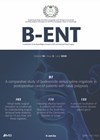
Journal Reviews
Canal wall up mastoid defects - can they be usefully reconstructed with hydroxyapatite cranioplastic cement?
Standard canal wall up (CWU) mastoid surgery leaves a mastoid defect of varying size, commonly covered by soft tissue. Rarely, this bony defect can cause discomfort, cosmetic issues or other problems. To mitigate these, the defect can be filled either...
Long-term curative effects of microvascular decompression for hemifacial spasm
This article describes results of a multicentre prospective trial performed to evaluate long- and short-term outcomes and complications of patients who underwent microvascular decompression (MVD) for hemifacial spasm (HFS). The surgeries were performed by surgeons with more than 15 years...
Well drilling vs. subperiosteal pocket for cochlear implants – comparison of operative time, complications and cost-effectiveness
The choice of method for securing the receiver/stimulator (R/S) package during cochlear implant surgery is usually dependant on several factors, but primarily surgeon preference. The initial recommendation from manufacturers was to drill a bony well (WD technique) and use bony...
Bone bridge conduction device for patients with bilateral microtia-atresia.
Management of microtia-atresia requires a multidisciplinary approach. Children normally require bone conduction hearing aid devices very early in life to improve and facilitate speech and language development. At a later stage, when the cranial bones have strengthened and become thicker,...
Efficacy of stereotactic radiosurgery for facial nerve schwannoma
This international multicentre study reviewed the results of stereotactic radiosurgery (SRS) in 63 patients with facial nerve schwannoma over three decades. The facial nerve schwannoma were distinguished from vestibular schwannoma based on intraoperative findings or typical temporal or extra temporal...
Reflux, a pre-disposing factor in paediatric OME?
It is almost 20 years since the Lancet publication by Tasker et al describing gastric juice in the glue ear of children. This paper attempts to look at the body of literature which has focused specifically on the clinical association...
The medially-invasive cholesteatoma: a case series
In this small case series, Casazza et al describe their management of seven cases of complex cholesteatoma presenting during a 16-year period. Patients were included if imaging confirmed restricted diffusion and an endophytic, medially-destructive disease involving the otic capsule, petrous...
‘Acoustic shock’
Development of hearing loss due to traditional and steady state noise in working environments has well defined medical, physical and legal implications in the present times. Organisations not complying with ‘Noise at Work Regulations 1989’ are liable for compensation if...
Endoscopic stapes surgery - pearls and pitfalls
Endoscopic ear surgery has gained popularity in recent years with wide panoramic visualisation of the operative field one of its key strengths. This article summarises the approach, set-up and outcomes of patients undergoing endoscopic stapes surgery. A key step during...
Dizziness in OSA patients– is there a link and can CPAP treat it?
This is a small study which proposes an interesting hypothesis - that in patients with both dizziness and OSA, treatment of their sleep disorder can provide resolution of their dizziness symptoms, which were otherwise refractory to standard treatment, particularly in...
Virtual reality surgical simulation for the temporal bone
This prospective study looked at 15 otorhinolaryngology residents in Belgium to see if using the VOXEL-MAN Tempo surgical simulator system improved their understanding of temporal bone radiological anatomy. As a secondary aim, they also assessed whether there was any improvement...
3D-printed temporal bone models - how good can they be?
In the era of increasingly difficult and expensive-to-come-by cadaveric temporal bones with which to practise drilling and learn the complex 3D anatomy of the temporal bone, decent alternatives would be welcome. McMillan et al report a prospective comparison study in...
















